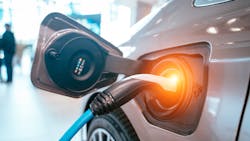EVs and the challenges faced by repair shop owners
Content brought to you by Motor Age. To subscribe, click here.
Electric vehicles (EVs) have become an increasingly popular option for consumers in recent years. As climate change concerns continue to grow, many people are looking for ways to reduce their carbon footprint and lessen their impact on the environment. EVs offer a cleaner, more sustainable alternative to traditional gas-powered vehicles, and this trend is only expected to continue. As we explore the consumer trend toward EVs, we also need to explore the potential impact on the automotive repair industry.
How and why the EV market is growing rapidly
First and foremost, the market for EVs is growing rapidly. According to the International Energy Agency (IEA), global EV sales [both plug-in hybrid electric vehicles (PHEVs) and battery electric vehicles (BEVs)] surpassed 6.9 million units in 2021, a 107 percent increase from 2020. In 2022, EV sales worldwide exceeded 10.5 million units, a 55 percent increase over 2021. While EVs still represent a relatively small share of the overall automotive market, their growth is expected to rapidly accelerate in coming years. Many automakers have announced plans to invest heavily in EV technology, and governments around the world are implementing policies to encourage EV adoption, such as tax incentives, subsidies and investment in the necessary infrastructure to support this effort.
One of the primary reasons for the increasing popularity of EVs is their environmental benefits. Unlike traditional gas-powered vehicles, EVs produce zero emissions from the tailpipe, meaning they don't contribute to air pollution. This is a significant advantage, particularly in urban areas where air quality is a major concern. Furthermore, EVs are powered by electricity, which can be generated from renewable sources like wind and solar energy, making them even more environmentally friendly.
Another reason for the trend toward EVs is their lower operating costs. While the upfront cost of an EV is often higher than a gas-powered vehicle, they are cheaper to operate over their lifetime. EVs require less maintenance and are more energy-efficient than traditional cars, resulting in lower fuel and operating costs. Additionally, as the cost of batteries continues to decrease, EVs are becoming more affordable, and their driving range is increasing, making them a more practical choice for consumers.
However, there are still some challenges to the widespread adoption of EVs. One of the most significant challenges is the lack of charging infrastructure. While EV charging stations are becoming more common, they are not yet as widely available as gas stations. This can be a concern for consumers, particularly those who live in apartments or don't have access to a garage or driveway to charge their vehicle overnight. Additionally, the limited driving range of some EVs can be a concern for drivers who frequently take long trips.
Clearly, the trend toward electric vehicles is a positive development for the environment and the automotive industry. With increasing concerns about climate change and the environmental impact of traditional vehicles, EVs offer a cleaner, more sustainable alternative. While there are still some challenges to widespread adoption, the market for EVs is growing rapidly, and automakers and governments are investing in EV technology and infrastructure. As EVs become more affordable and their driving range increases, it is likely that they will become an increasingly popular choice for consumers in the years ahead.
Challenge number 1: A lack of EV technology knowledge and training
A primary challenge for repair shop owners in the midst of this transition is the general lack of knowledge and training around EV technology. Unlike traditional cars, EVs have a significantly different powertrain and electrical system, and our technicians will require specialized training and equipment to service them effectively. Many repair shop owners who have spent years specializing in traditional vehicles may not have the necessary financial resources, knowledge or equipment to repair EVs, which can be a significant barrier to entry into the emerging EV repair market.
Challenge number 2: Limited availability of EV parts and tools
Another challenge is the limited availability of parts and tools required for EV repairs. Because EV technology is relatively new, many manufacturers offer replacement parts and specialized tools only to authorized dealerships, making it difficult for independent repair shops to access them. This can lead to longer wait times for repairs and higher costs for consumers, as independent repair shops may need to outsource repairs or purchase expensive equipment to service EVs.
Challenge number 3: Impact on repair shop business models
In addition to these challenges, there are also concerns around the potential impact on the business models of repair shop owners. Because EVs require less maintenance and have fewer moving parts than traditional vehicles, they may not require the same level of ongoing repairs and services. This could lead to a decline in demand for traditional repair services, potentially leading to a decrease in revenue for repair shop owners, which would be of great concern.
Despite these challenges, there are also opportunities for repair shop owners in the EV market. As more and more consumers make the switch to EVs, the demand for repair and maintenance services will inevitably increase. This presents an opportunity for repair shop owners to diversify their services and invest in EV training and equipment, positioning themselves as leaders in the emerging EV repair market.
Where to find help
To address some of these challenges, governments and industry groups are working to develop standards and training programs for EV repair technicians. In the US, for example, the National Institute for Automotive Service Excellence (ASE) offers certification programs for EV technicians, and the Automotive Maintenance and Repair Association (AMRA) provides training and resources for independent repair shop owners. With the right investment in training and equipment, repair shop owners can position themselves to capitalize on the growing demand for EV repair and maintenance services, ensuring the sustainability and growth of their businesses in the years ahead.
How and why the industry will change
Electric vehicles represent only the latest evolution of the automotive repair industry. Quick lubes are likely to fade from the automotive landscape over time, just as tune-up shops, muffler shops and radiator shops mostly have, while batteries and battery replacements may emerge as viable standalone business models. Gas-powered cars are going to be a part of the automotive landscape for many years to come, but clearly the slice of that pie taken up by EVs will be growing ever-larger as the gas-powered slice grows ever-smaller. And certainly, that will impact how we go about our business, what we train, who we retain, who we hire, and who we will be recruiting going forward.
The automotive repair industry has always been adaptable to change; this is nothing new. But the challenges presented by EVs are significant, far-reaching, and cannot be ignored. As an industry, we have an opportunity to dive in and get out in front of this or be overwhelmed by what is clearly here at our doorstep. The road forward is very uncertain, with huge risks, but our path is clear.
It’s time to adapt as we are able, to learn and to overcome. It’s what we do.
About the Author
Brian Canning
Brian Canning is 30-year veteran of the automotive repair industry who moved to the federal sector as a business analyst and later change management specialist. For many years, he worked for a leading coaching company as a leadership and management coach and team leader, working with tire and repair shop owners from across the country. He started his career as a Goodyear service manager in suburban Washington, D.C., moving on to oversee several stores and later a region. He also has been a retail sales manager for a distributor, run a large fleet operation, and headed a large multi-state sales territory for an independent manufacturer of automotive parts.

